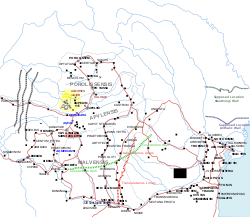- Constantine's Bridge (Danube)
-
Constantine's Bridge Crosses Danube Locale Celeiu, Romania and Oescus, Bulgaria Total length 2,437 m (7,995 ft) Width 5.7 m (19 ft) Height 10 m (33 ft) Construction end 328 AD 
Coordinates 43°45′49″N 24°27′25″E / 43.76361°N 24.45694°E Constantine's Bridge on the map Constantine's Bridge (Romanian: Podul lui Constantin cel Mare; Bulgarian: Мост на Константин Велики, Most na Konstantin Veliki) was a Roman bridge over the Danube. It was completed or rebuilt[1] in 328 and remained in use for no more than four decades.[2] With an overall length of 2437 m, 1137 m of which spanned the Danube's riverbed,[3] Constantine's Bridge is considered the longest ancient river bridge and one of the longest of all time.[4]
Contents
Construction
It was a construction with masonry piers and wooden arch bridge and with wooden superstructure. It was constructed between the present-day Romanian town Corabia, Olt County - then the city of Sucidava and the Bulgarian Gigen Village, Pleven Province (ancient Oescus),[5][6] by Constantine the Great.[7] The bridge was apparently used until the mid 4th century,[8] the main reason for this assumption being the fact that Valens had to cross the Danube using a bridge of boats at Constantiana Daphne during his campaign against the Goths in 367.[9]
Technical Data
The length of the Bridge was 2434 m with a wooden deck with a width of 5.70m at 10 meters above the water.[10] The bridge had two abutment piers at each end, serving as gates for the bridge.
Researches
While Marsigli attempted to locate the bridge in the 17th century and Alexandru Popovici and Cezar Bolliac worked in the nineteenth, the first real scientific discoveries were performed by Grigore Tocilescu and Pamfil Polonic in 1902. In 1934 Dumitru Tudor published the first complete work regarding the bridge, and the last systematic approach on the north bank of the Danube was performed in 1968 by Octavian Toropu.
See also
References
- ^ Biblioteca „V.A. Urechia“ site http://www.bvau.ro/docs/doc_eng.htm
- ^ Pontica nr.40 page 360
- ^ Both figures from: Tudor 1974, p. 139; Galliazzo 1994, p. 319
- ^ Galliazzo 1994, p. 319
- ^ Pamfil Polonic aflate în arhiva Muzeului Naţional de Antichităţi — Institutul de Arheologie „Vasile Pârvan” http://www.cimec.ro/Arheologie/ArhivaDigitala/4Pamfil20Polonic/PolonicP_Varia_71planse/Planse_sumar.htm
- ^ Pamfil Polonic aflate în arhiva Muzeului Naţional de Antichităţi — Institutul de Arheologie „Vasile Pârvan” http://www.cimec.ro/Arheologie/Digitalarchives/4Pamfil%20Polonic/Polonic.htm
- ^ International Database Of Structures http://en.structurae.de/structures/data/index.cfm?ID=s0003933
- ^ CIMEC Archeologica report http://www.cimec.ro/scripts/arh/cronica/detail.asp?k=2210
- ^ Kulikowski, Michael (2007). Rome's Gothic Wars. Cambridge University Press. pp. 116–117. ISBN 0521846331. at Google Book Search
- ^ Pontica 2007 page 360
Further reading
- Galliazzo, Vittorio (1994), I ponti romani. Catalogo generale, Vol. 2, Treviso: Edizioni Canova, pp. 319f. (No. 645), ISBN 88-85066-66-6
- Tudor, D. (1974), "Le pont de Constantin le Grand à Celei", Les ponts romains du Bas-Danube, Bibliotheca Historica Romaniae Études, 51, Bucharest: Editura Academiei Republicii Socialiste România, pp. 135–166
Roman bridges England France Pont Ambroix • Pont de Bornègre • Pont Flavien • Pont du Gard • Pont Julien • Pont sur la Laye • Pont des Marchands • Pont Serme • Roman Bridge (Saint-Thibéry) • Roman Bridge (Vaison-la-Romaine) Germany Iran Band-e Kaisar Italy Pons Aemilius • Pons Agrippae • Ponte Altinate • Pons Cestius • Pons Fabricius • Pons Neronianus • Pons Probi • Pons Sublicius • Pont d'Aël • Pont de Pierre (Aosta) • Pont-Saint-Martin • Ponte d'Augusto (Rimini) • Ponte Corvo • Ponte del Gran Caso • Ponte Milvio • Ponte Molino (Padua) • Ponte Nomentano • Ponte Pietra (Verona) • Ponte di Pioraco • Ponte di Quintodecimo • Ponte Salario • Ponte San Lorenzo • Ponte Sant'Angelo • Susegana Bridge Lebanon Leontes Bridge Portugal Ponte de Rubiães • Ponte Nova da Cava da Velha • Roman Bridge (Chaves) Romania Constantine's Bridge (Danube) • Trajan's Bridge Spain Acueducto de los Milagros • Alcántara Bridge • Alcántara Bridge (Toletum) • Alconétar Bridge • Aqüeducte de les Ferreres • Puente Romano (Mérida) • Segovia Aqueduct Bridge Syria Bridge at Nimreh • Gemarrin Bridge • Kharaba Bridge Turkey Aesepus Bridge • Arapsu Bridge • Bridge at Oinoanda • Constantine's Bridge (Mysia) • Eurymedon Bridge (Aspendos) • Eurymedon Bridge (Selge) • Karamagara Bridge • Kemer Bridge • Limyra Bridge • Makestos Bridge • Nysa Bridge • Penkalas Bridge • Pergamon Bridge • Sangarius Bridge • Severan Bridge • Taşköprü (Adana) • Valens Aqueduct Bridge • White Bridge (Mysia) Bridges of the Danube Upstream
Vidin–Calafat BridgeConstantine's Bridge Downstream
Giurgiu-Rousse Friendship BridgeCategories:- 328 works
- 4th-century bridges
- Roman bridges
- Bridges over the Danube
- Demolished bridges
- Bridges in Romania
- Bridges in Bulgaria
- Roman Dacia
- History of Bulgaria
- Olt County
- Pleven Province
- History of Romania
Wikimedia Foundation. 2010.

